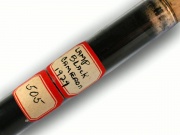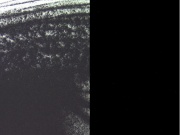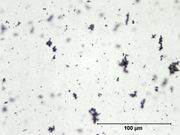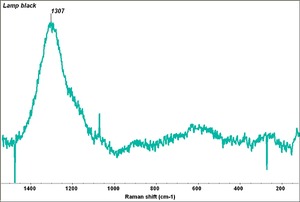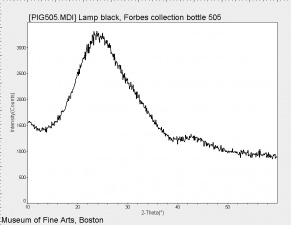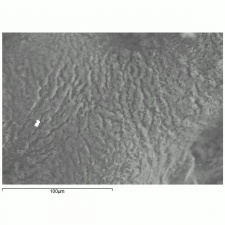Difference between revisions of "Lampblack"
| (2 intermediate revisions by the same user not shown) | |||
| Line 1: | Line 1: | ||
[[File:505 lampblack.jpg|thumb|Lampblack]] | [[File:505 lampblack.jpg|thumb|Lampblack]] | ||
== Description == | == Description == | ||
| − | + | [[File:lampblack C100x.jpg|thumb|lampblack (at 100x visible light left; UV light right)]] | |
A type of carbon black obtained from the soot of burned [[fat]], [[oil]], [[tar]], or [[natural resin|resin]]. Lampblack is soft bluish-black pigment that is very stable and unaffected by [[visible radiation|light]], [[acid|acids]], and [[alkali|alkalis]]. It was often mixed with [[lead white]] to produce a gray pigment. Lampblack may contain a small percentage of residual fats, oils, or resins. This makes it mix poorly with [[water]] and also makes [[linseed oil]] dry slowly into a soft film. [[Umber]] was often added to the mixture as a drier. For use as a [[watercolor paint|watercolor]], lampblack was mixed with [[glue]], prepared in sticks and sold as [[India ink]]. Lampblack was one of the major black pigment in early American house paints (Newman and Farrell 1994). Currently lampblack is used as a black pigment in [[cement|cements]], [[ceramic|ceramics]], [[ink|inks]], [[linoleum]], [[crayon|crayons]], shoe polishes, and [[carbon paper]]. | A type of carbon black obtained from the soot of burned [[fat]], [[oil]], [[tar]], or [[natural resin|resin]]. Lampblack is soft bluish-black pigment that is very stable and unaffected by [[visible radiation|light]], [[acid|acids]], and [[alkali|alkalis]]. It was often mixed with [[lead white]] to produce a gray pigment. Lampblack may contain a small percentage of residual fats, oils, or resins. This makes it mix poorly with [[water]] and also makes [[linseed oil]] dry slowly into a soft film. [[Umber]] was often added to the mixture as a drier. For use as a [[watercolor paint|watercolor]], lampblack was mixed with [[glue]], prepared in sticks and sold as [[India ink]]. Lampblack was one of the major black pigment in early American house paints (Newman and Farrell 1994). Currently lampblack is used as a black pigment in [[cement|cements]], [[ceramic|ceramics]], [[ink|inks]], [[linoleum]], [[crayon|crayons]], shoe polishes, and [[carbon paper]]. | ||
| − | See also [[bone black]], [[charcoal black]], and [[vine black]]. | + | See also [[bone black]], [[charcoal black]], [[ivory black]] and [[vine black]]. |
| − | + | [[File:50_Lampblack_500X.jpg|thumb|Lampblack at 500x]] | |
| − | [[File: | ||
== Synonyms and Related Terms == | == Synonyms and Related Terms == | ||
| Line 13: | Line 12: | ||
[[[SliderGallery rightalign|Lamp black copy.tif~Raman (MFA)|PIG505.jpg~XRD|f505sem.jpg~SEM|f505edsbw.jpg~EDS]]] | [[[SliderGallery rightalign|Lamp black copy.tif~Raman (MFA)|PIG505.jpg~XRD|f505sem.jpg~SEM|f505edsbw.jpg~EDS]]] | ||
| + | == Risks == | ||
| − | == | + | Repeated skin contact may lead to skin cancer due to impurities. Chronic inhalation may cause irritation to sinus and lung tissue. Nonflammable. |
| + | == Physical and Chemical Properties == | ||
ASTM (1999) lightfastness = I (excellent) | ASTM (1999) lightfastness = I (excellent) | ||
| Line 30: | Line 31: | ||
|} | |} | ||
| − | == | + | == Resources and Citations == |
| − | |||
| − | |||
| − | + | * J.Winter, "The Characterization of Pigments Based on Carbon" ''Studies in Conservation'', 28:49-66, 1983. | |
| − | + | * R. Newman, E. Farrell, "House Paint Pigments" in ''Paint in America'', R. Moss ed., Preservation Press, NY 1994 | |
| − | |||
| − | |||
| − | |||
| − | |||
| − | |||
| − | |||
| − | |||
| − | |||
| − | |||
| − | |||
| − | |||
* Thomas Gregory, ''The Condensed Chemical Dictionary'', Reinhold Publishing, New York, 3rd ed., 1942 Comment: Syn= Germantown black | * Thomas Gregory, ''The Condensed Chemical Dictionary'', Reinhold Publishing, New York, 3rd ed., 1942 Comment: Syn= Germantown black | ||
| Line 70: | Line 58: | ||
* ''Dictionary of Building Preservation'', Ward Bucher, ed., John Wiley & Sons, Inc., New York City, 1996 | * ''Dictionary of Building Preservation'', Ward Bucher, ed., John Wiley & Sons, Inc., New York City, 1996 | ||
| − | |||
| − | |||
* Monona Rossol, ''The Artist's Complete Health and Safety Guide'', Allworth Press, New York, 1994 | * Monona Rossol, ''The Artist's Complete Health and Safety Guide'', Allworth Press, New York, 1994 | ||
| − | * Website | + | * Website: http://www.coloria.net/varita.htm - foreign language equivalent terms |
* Random House, ''Webster's Encyclopedic Unabridged Dictionary of the English Language'', Grammercy Book, New York, 1997 | * Random House, ''Webster's Encyclopedic Unabridged Dictionary of the English Language'', Grammercy Book, New York, 1997 | ||
Latest revision as of 15:33, 7 September 2022
Description
A type of carbon black obtained from the soot of burned Fat, Oil, Tar, or resin. Lampblack is soft bluish-black pigment that is very stable and unaffected by light, acids, and alkalis. It was often mixed with Lead white to produce a gray pigment. Lampblack may contain a small percentage of residual fats, oils, or resins. This makes it mix poorly with Water and also makes Linseed oil dry slowly into a soft film. Umber was often added to the mixture as a drier. For use as a watercolor, lampblack was mixed with Glue, prepared in sticks and sold as India ink. Lampblack was one of the major black pigment in early American house paints (Newman and Farrell 1994). Currently lampblack is used as a black pigment in cements, ceramics, inks, Linoleum, crayons, shoe polishes, and Carbon paper.
See also Bone black, Charcoal black, Ivory black and Vine black.
Synonyms and Related Terms
lamp black; carbon black; Pigment Black 6; CI 77266; Lampenschwarz (Deut.); Flamruss (Deut.); negro de humo (Esp.); lamppumusta (Fin.); noir de fumée (Fr.); noir de bougie (Fr.); karboyno (Gr.); nero di lampada (It.); bistro (It.); ner d'olio (It.); nero fiamma (It.); nero di fumo (It.); lampenzwart (Ned.); negro de fumo (Port.); lamp-black; smoke black; soot black; oil black; flame black; blacking; blue black; Germantown black
Risks
Repeated skin contact may lead to skin cancer due to impurities. Chronic inhalation may cause irritation to sinus and lung tissue. Nonflammable.
Physical and Chemical Properties
ASTM (1999) lightfastness = I (excellent)
| Composition | carbon |
|---|---|
| Density | 1.77 |
| Refractive Index | opaque |
Resources and Citations
- J.Winter, "The Characterization of Pigments Based on Carbon" Studies in Conservation, 28:49-66, 1983.
- R. Newman, E. Farrell, "House Paint Pigments" in Paint in America, R. Moss ed., Preservation Press, NY 1994
- Thomas Gregory, The Condensed Chemical Dictionary, Reinhold Publishing, New York, 3rd ed., 1942 Comment: Syn= Germantown black
- Richard S. Lewis, Hawley's Condensed Chemical Dictionary, Van Nostrand Reinhold, New York, 10th ed., 1993
- The Merck Index, Martha Windholz (ed.), Merck Research Labs, Rahway NJ, 10th edition, 1983 Comment: entry #1056
- The Dictionary of Art, Grove's Dictionaries Inc., New York, 1996 Comment: 'Pigment'
- R. J. Gettens, G.L. Stout, Painting Materials, A Short Encyclopaedia, Dover Publications, New York, 1966
- Ralph Mayer, A Dictionary of Art Terms and Techniques, Harper and Row Publishers, New York, 1969 (also 1945 printing)
- Matt Roberts, Don Etherington, Bookbinding and the Conservation of Books: a Dictionary of Descriptive Terminology, U.S. Government Printing Office, Washington DC, 1982
- Reed Kay, The Painter's Guide To Studio Methods and Materials, Prentice-Hall, Inc., Englewood Cliffs, NJ, 1983
- Michael McCann, Artist Beware, Watson-Guptill Publications, New York City, 1979
- R.D. Harley, Artists' Pigments c. 1600-1835, Butterworth Scientific, London, 1982
- Dictionary of Building Preservation, Ward Bucher, ed., John Wiley & Sons, Inc., New York City, 1996
- Monona Rossol, The Artist's Complete Health and Safety Guide, Allworth Press, New York, 1994
- Website: http://www.coloria.net/varita.htm - foreign language equivalent terms
- Random House, Webster's Encyclopedic Unabridged Dictionary of the English Language, Grammercy Book, New York, 1997
- The American Heritage Dictionary or Encarta, via Microsoft Bookshelf 98, Microsoft Corp., 1998
- Art and Architecture Thesaurus Online, http://www.getty.edu/research/tools/vocabulary/aat/, J. Paul Getty Trust, Los Angeles, 2000
